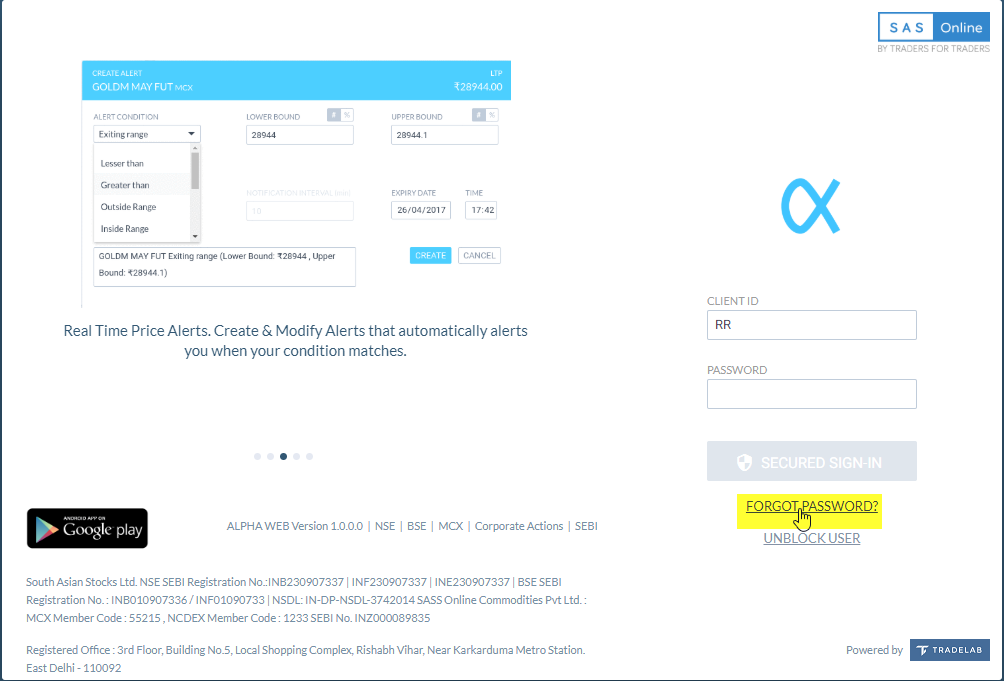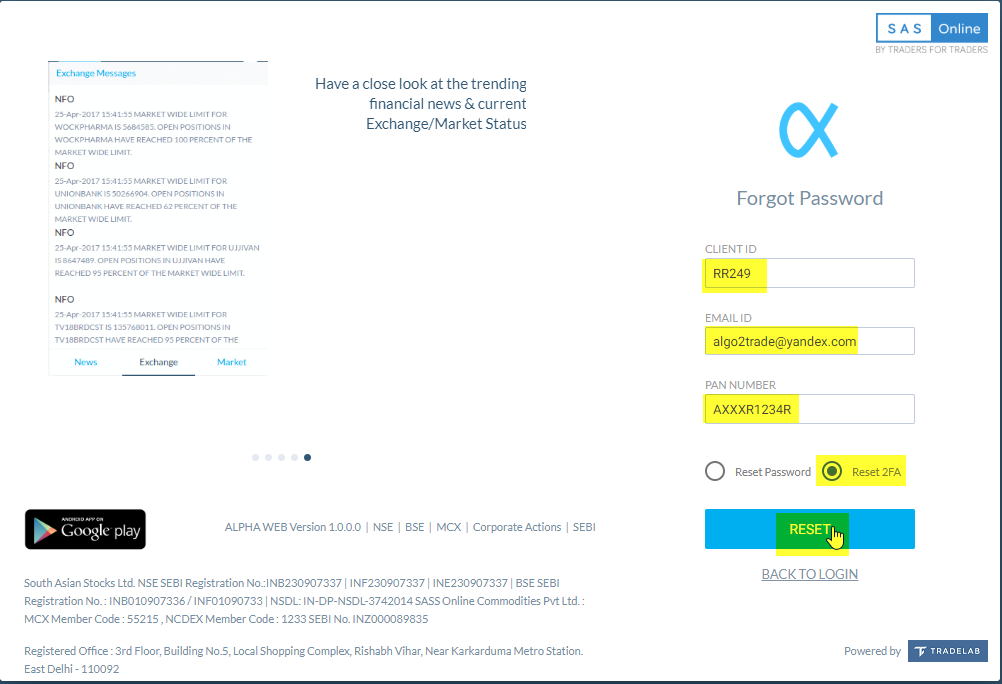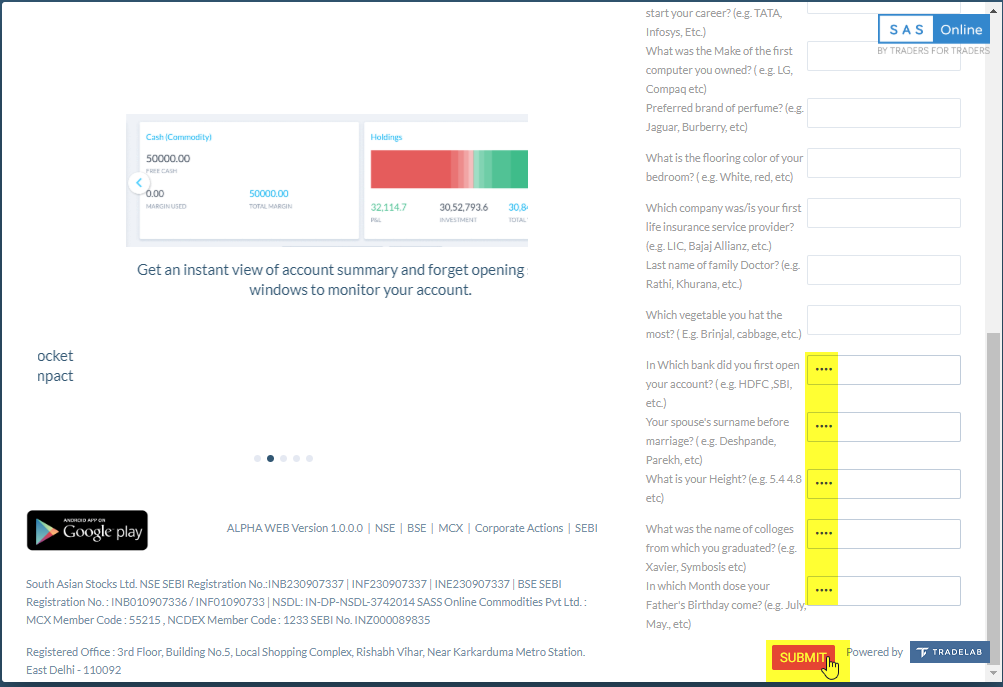The Python APIs for communicating with the SAS Online Alpha Trade Web Platform.
Alpha Trade Python library provides an easy to use python wrapper over the HTTPS APIs.
The HTTP calls have been converted to methods and JSON responses are wrapped into Python-compatible objects.
Websocket connections are handled automatically within the library.
This work is completely based on Python SDK / APIs for AliceBlueOnline.
Thanks to krishnavelu.
- Author: algo2t
- Github Repository: alphatrade
This module is installed via pip:
pip install git+https://github.com/algo2t/alphatrade.git
It can also be installed from pypi
pip install alphatrade
To force upgrade existing installations:
pip uninstall alphatrade
pip --no-cache-dir install --upgrade alphatrade
Python 3.x
Also, you need the following modules:
protlibwebsocket_clientrequestspandas
The modules can also be installed using pip
Please clone this repository and check the examples folder to get started.
Check here
There is only one class in the whole library: AlphaTrade. When the AlphaTrade object is created an access token from the SAS Online alpha trade server is stored in text file access_token.txt in the same directory. An access token is valid for 24 hours. See the examples folder with config.py file to see how to store your credentials.
With an access token, you can instantiate an AlphaTrade object again. Ideally you only need to create an access_token once every day.
The original REST API that this SDK is based on is available online. Alice Blue API REST documentation
The whole library is equipped with python‘s logging module for debugging. If more debug information is needed, enable logging using the following code.
import logging
logging.basicConfig(level=logging.DEBUG)- Import alphatrade
from alphatrade import *- Create
config.pyfile
Always keep credentials in a separate file
login_id = "RR249"
password = "SAS@249"
twofa = "rr"
try:
access_token = open('access_token.txt', 'r').read().rstrip()
except Exception as e:
print('Exception occurred :: {}'.format(e))
access_token = None- Import the config
import config- Create
AlphaTradeobject with yourlogin_id,password,2FAand/oraccess_token.
Use config object to get login_id, password, twofa and access_token.
from alphatrade import AlphaTrade
import config
sas = AlphaTrade(login_id=config.login_id, password=config.password, twofa=config.twofa, access_token=config.access_token)- You can run commands here to check your connectivity
print(sas.get_balance()) # get balance / margin limits
print(sas.get_profile()) # get profile
print(sas.get_daywise_positions()) # get daywise positions
print(sas.get_netwise_positions()) # get netwise positions
print(sas.get_holding_positions()) # get holding positionsGetting master contracts allow you to search for instruments by symbol name and place orders.
Master contracts are stored as an OrderedDict by token number and by symbol name. Whenever you get a trade update, order update, or quote update, the library will check if master contracts are loaded. If they are, it will attach the instrument object directly to the update. By default all master contracts of all enabled exchanges in your personal profile will be downloaded. i.e. If your profile contains the following as enabled exchanges ['NSE', 'BSE', 'CDS', 'MCX', NFO'] all contract notes of all exchanges will be downloaded by default. If you feel it takes too much time to download all exchange, or if you don‘t need all exchanges to be downloaded, you can specify which exchange to download contract notes while creating the AlphaTrade object.
sas = AlphaTrade(login_id=config.login_id, password=config.password, twofa=config.twofa, access_token=config.access_token, master_contracts_to_download=['NSE', 'BSE'])This will reduce a few milliseconds in object creation time of AlphaTrade object.
Symbols can be retrieved in multiple ways. Once you have the master contract loaded for an exchange, you can get an instrument in many ways.
Get a single instrument by it‘s name:
tatasteel_nse_eq = sas.get_instrument_by_symbol('NSE', 'TATASTEEL')
reliance_nse_eq = sas.get_instrument_by_symbol('NSE', 'RELIANCE')
ongc_bse_eq = sas.get_instrument_by_symbol('BSE', 'ONGC')
india_vix_nse_index = sas.get_instrument_by_symbol('NSE', 'India VIX')
sensex_nse_index = sas.get_instrument_by_symbol('BSE', 'SENSEX')Get a single instrument by it‘s token number (generally useful only for BSE Equities):
ongc_bse_eq = sas.get_instrument_by_token('BSE', 500312)
reliance_bse_eq = sas.get_instrument_by_token('BSE', 500325)
acc_nse_eq = sas.get_instrument_by_token('NSE', 22)Get FNO instruments easily by mentioning expiry, strike & call or put.
bn_fut = sas.get_instrument_for_fno(symbol = 'BANKNIFTY', expiry_date=datetime.date(2019, 6, 27), is_fut=True, strike=None, is_call = False)
bn_call = sas.get_instrument_for_fno(symbol = 'BANKNIFTY', expiry_date=datetime.date(2019, 6, 27), is_fut=False, strike=30000, is_call = True)
bn_put = sas.get_instrument_for_fno(symbol = 'BANKNIFTY', expiry_date=datetime.date(2019, 6, 27), is_fut=False, strike=30000, is_call = False)Search for multiple instruments by matching the name. This works case insensitive and returns all instrument which has the name in its symbol.
all_sensex_scrips = sas.search_instruments('BSE', 'sEnSeX')
print(all_sensex_scrips)The above code results multiple symbol which has ‘sensex’ in its symbol.
[Instrument(exchange='BSE', token=1, symbol='SENSEX', name='SENSEX', expiry=None, lot_size=None), Instrument(exchange='BSE', token=540154, symbol='IDFSENSEXE B', name='IDFC Mutual Fund', expiry=None, lot_size=None), Instrument(exchange='BSE', token=532985, symbol='KTKSENSEX B', name='KOTAK MAHINDRA MUTUAL FUND', expiry=None, lot_size=None), Instrument(exchange='BSE', token=538683, symbol='NETFSENSEX B', name='NIPPON INDIA ETF SENSEX', expiry=None, lot_size=None), Instrument(exchange='BSE', token=535276, symbol='SBISENSEX B', name='SBI MUTUAL FUND - SBI ETF SENS', expiry=None, lot_size=None)]
Search for multiple instruments by matching multiple names
multiple_underlying = ['BANKNIFTY','NIFTY','INFY','BHEL']
all_scripts = sas.search_instruments('NFO', multiple_underlying)Instruments are represented by instrument objects. These are named-tuples that are created while getting the master contracts. They are used when placing an order and searching for an instrument. The structure of an instrument tuple is as follows:
Instrument = namedtuple('Instrument', ['exchange', 'token', 'symbol',
'name', 'expiry', 'lot_size'])All instruments have the fields mentioned above. Wherever a field is not applicable for an instrument (for example, equity instruments don‘t have strike prices), that value will be None
Once you have master contracts loaded, you can easily subscribe to quote updates.
You can subscribe any one type of quote update for a given scrip. Using the LiveFeedType enum, you can specify what type of live feed you need.
LiveFeedType.MARKET_DATALiveFeedType.COMPACTLiveFeedType.SNAPQUOTELiveFeedType.FULL_SNAPQUOTE
Please refer to the original documentation here for more details of different types of quote update.
sas.subscribe(sas.get_instrument_by_symbol('NSE', 'TATASTEEL'), LiveFeedType.MARKET_DATA)
sas.subscribe(sas.get_instrument_by_symbol('BSE', 'RELIANCE'), LiveFeedType.COMPACT)Subscribe to multiple instruments in a single call. Give an array of instruments to be subscribed.
sas.subscribe([sas.get_instrument_by_symbol('NSE', 'TATASTEEL'), sas.get_instrument_by_symbol('NSE', 'ACC')], LiveFeedType.MARKET_DATA)Note: There is a limit of 250 scrips that can be subscribed on total. Beyond this point the server may disconnect web-socket connection.
Start getting live feed via socket
socket_opened = False
def event_handler_quote_update(message):
print(f"quote update {message}")
def open_callback():
global socket_opened
socket_opened = True
sas.start_websocket(subscribe_callback=event_handler_quote_update,
socket_open_callback=open_callback,
run_in_background=True)
while(socket_opened==False):
pass
sas.subscribe(sas.get_instrument_by_symbol('NSE', 'ONGC'), LiveFeedType.MARKET_DATA)
sleep(10)Unsubscribe to an existing live feed
sas.unsubscribe(sas.get_instrument_by_symbol('NSE', 'TATASTEEL'), LiveFeedType.MARKET_DATA)
sas.unsubscribe(sas.get_instrument_by_symbol('BSE', 'RELIANCE'), LiveFeedType.COMPACT)Unsubscribe to multiple instruments in a single call. Give an array of instruments to be unsubscribed.
sas.unsubscribe([sas.get_instrument_by_symbol('NSE', 'TATASTEEL'), sas.get_instrument_by_symbol('NSE', 'ACC')], LiveFeedType.MARKET_DATA)sas.get_all_subscriptions() # AllSubscribe to market status messages
sas.subscribe_market_status_messages()Getting market status messages.
print(sas.get_market_status_messages())Example result of get_market_status_messages()
[{'exchange': 'NSE', 'length_of_market_type': 6, 'market_type': b'NORMAL', 'length_of_status': 31, 'status': b'The Closing Session has closed.'}, {'exchange': 'NFO', 'length_of_market_type': 6, 'market_type': b'NORMAL', 'length_of_status': 45, 'status': b'The Normal market has closed for 22 MAY 2020.'}, {'exchange': 'CDS', 'length_of_market_type': 6, 'market_type': b'NORMAL', 'length_of_status': 45, 'status': b'The Normal market has closed for 22 MAY 2020.'}, {'exchange': 'BSE', 'length_of_market_type': 13, 'market_type': b'OTHER SESSION', 'length_of_status': 0, 'status': b''}]
Note: As per alice blue documentation all market status messages should be having a timestamp. But in actual the server doesn‘t send timestamp, so the library is unable to get timestamp for now.
Subscribe to exchange messages
sas.subscribe_exchange_messages()Getting market status messages.
print(sas.get_exchange_messages())Example result of get_exchange_messages()
[{'exchange': 'NSE', 'length': 32, 'message': b'DS : Bulk upload can be started.', 'exchange_time_stamp': 1590148595}, {'exchange': 'NFO', 'length': 200, 'message': b'MARKET WIDE LIMIT FOR VEDL IS 183919959. OPEN POSITIONS IN VEDL HAVE REACHED 84 PERCENT OF THE MARKET WIDE LIMIT. ', 'exchange_time_stamp': 1590146132}, {'exchange': 'CDS', 'length': 54, 'message': b'DS : Regular segment Bhav copy broadcast successfully.', 'exchange_time_stamp': 1590148932}, {'exchange': 'MCX', 'length': 7, 'message': b'.......', 'exchange_time_stamp': 1590196159}]
socket_opened = False
def market_status_messages(message):
print(f"market status messages {message}")
def exchange_messages(message):
print(f"exchange messages {message}")
def open_callback():
global socket_opened
socket_opened = True
sas.start_websocket(market_status_messages_callback=market_status_messages,
exchange_messages_callback=exchange_messages,
socket_open_callback=open_callback,
run_in_background=True)
while(socket_opened==False):
pass
sas.subscribe_market_status_messages()
sas.subscribe_exchange_messages()
sleep(10)Place limit, market, SL, SL-M, AMO, BO, CO orders
print (sas.get_profile())
# TransactionType.Buy, OrderType.Market, ProductType.Delivery
print ("%%%%%%%%%%%%%%%%%%%%%%%%%%%%1%%%%%%%%%%%%%%%%%%%%%%%%%%%%%")
print(
sas.place_order(transaction_type = TransactionType.Buy,
instrument = sas.get_instrument_by_symbol('NSE', 'INFY'),
quantity = 1,
order_type = OrderType.Market,
product_type = ProductType.Delivery,
price = 0.0,
trigger_price = None,
stop_loss = None,
square_off = None,
trailing_sl = None,
is_amo = False)
)
# TransactionType.Buy, OrderType.Market, ProductType.Intraday
print ("%%%%%%%%%%%%%%%%%%%%%%%%%%%%2%%%%%%%%%%%%%%%%%%%%%%%%%%%%%")
print(
sas.place_order(transaction_type = TransactionType.Buy,
instrument = sas.get_instrument_by_symbol('NSE', 'INFY'),
quantity = 1,
order_type = OrderType.Market,
product_type = ProductType.Intraday,
price = 0.0,
trigger_price = None,
stop_loss = None,
square_off = None,
trailing_sl = None,
is_amo = False)
)
# TransactionType.Buy, OrderType.Market, ProductType.CoverOrder
print ("%%%%%%%%%%%%%%%%%%%%%%%%%%%%3%%%%%%%%%%%%%%%%%%%%%%%%%%%%%")
print(
sas.place_order(transaction_type = TransactionType.Buy,
instrument = sas.get_instrument_by_symbol('NSE', 'INFY'),
quantity = 1,
order_type = OrderType.Market,
product_type = ProductType.CoverOrder,
price = 0.0,
trigger_price = 7.5, # trigger_price Here the trigger_price is taken as stop loss (provide stop loss in actual amount)
stop_loss = None,
square_off = None,
trailing_sl = None,
is_amo = False)
)
# TransactionType.Buy, OrderType.Limit, ProductType.BracketOrder
# OCO Order can't be of type market
print ("%%%%%%%%%%%%%%%%%%%%%%%%%%%%4%%%%%%%%%%%%%%%%%%%%%%%%%%%%%")
print(
sas.place_order(transaction_type = TransactionType.Buy,
instrument = sas.get_instrument_by_symbol('NSE', 'INFY'),
quantity = 1,
order_type = OrderType.Limit,
product_type = ProductType.BracketOrder,
price = 8.0,
trigger_price = None,
stop_loss = 6.0,
square_off = 10.0,
trailing_sl = None,
is_amo = False)
)
# TransactionType.Buy, OrderType.Limit, ProductType.Intraday
print ("%%%%%%%%%%%%%%%%%%%%%%%%%%%%5%%%%%%%%%%%%%%%%%%%%%%%%%%%%%")
print(
sas.place_order(transaction_type = TransactionType.Buy,
instrument = sas.get_instrument_by_symbol('NSE', 'INFY'),
quantity = 1,
order_type = OrderType.Limit,
product_type = ProductType.Intraday,
price = 8.0,
trigger_price = None,
stop_loss = None,
square_off = None,
trailing_sl = None,
is_amo = False)
)
# TransactionType.Buy, OrderType.Limit, ProductType.CoverOrder
print ("%%%%%%%%%%%%%%%%%%%%%%%%%%%%6%%%%%%%%%%%%%%%%%%%%%%%%%%%%%")
print(
sas.place_order(transaction_type = TransactionType.Buy,
instrument = sas.get_instrument_by_symbol('NSE', 'INFY'),
quantity = 1,
order_type = OrderType.Limit,
product_type = ProductType.CoverOrder,
price = 7.0,
trigger_price = 6.5, # trigger_price Here the trigger_price is taken as stop loss (provide stop loss in actual amount)
stop_loss = None,
square_off = None,
trailing_sl = None,
is_amo = False)
)
###############################
# TransactionType.Buy, OrderType.StopLossMarket, ProductType.Delivery
print ("%%%%%%%%%%%%%%%%%%%%%%%%%%%%7%%%%%%%%%%%%%%%%%%%%%%%%%%%%%")
print(
sas.place_order(transaction_type = TransactionType.Buy,
instrument = sas.get_instrument_by_symbol('NSE', 'INFY'),
quantity = 1,
order_type = OrderType.StopLossMarket,
product_type = ProductType.Delivery,
price = 0.0,
trigger_price = 8.0,
stop_loss = None,
square_off = None,
trailing_sl = None,
is_amo = False)
)
# TransactionType.Buy, OrderType.StopLossMarket, ProductType.Intraday
print ("%%%%%%%%%%%%%%%%%%%%%%%%%%%%8%%%%%%%%%%%%%%%%%%%%%%%%%%%%%")
print(
sas.place_order(transaction_type = TransactionType.Buy,
instrument = sas.get_instrument_by_symbol('NSE', 'INFY'),
quantity = 1,
order_type = OrderType.StopLossMarket,
product_type = ProductType.Intraday,
price = 0.0,
trigger_price = 8.0,
stop_loss = None,
square_off = None,
trailing_sl = None,
is_amo = False)
)
# TransactionType.Buy, OrderType.StopLossMarket, ProductType.CoverOrder
# CO order is of type Limit and And Market Only
# TransactionType.Buy, OrderType.StopLossMarket, ProductType.BO
# BO order is of type Limit and And Market Only
###################################
# TransactionType.Buy, OrderType.StopLossLimit, ProductType.Delivery
print ("%%%%%%%%%%%%%%%%%%%%%%%%%%%%9%%%%%%%%%%%%%%%%%%%%%%%%%%%%%")
print(
sas.place_order(transaction_type = TransactionType.Buy,
instrument = sas.get_instrument_by_symbol('NSE', 'INFY'),
quantity = 1,
order_type = OrderType.StopLossMarket,
product_type = ProductType.Delivery,
price = 8.0,
trigger_price = 8.0,
stop_loss = None,
square_off = None,
trailing_sl = None,
is_amo = False)
)
# TransactionType.Buy, OrderType.StopLossLimit, ProductType.Intraday
print ("%%%%%%%%%%%%%%%%%%%%%%%%%%%%10%%%%%%%%%%%%%%%%%%%%%%%%%%%%%")
print(
sas.place_order(transaction_type = TransactionType.Buy,
instrument = sas.get_instrument_by_symbol('NSE', 'INFY'),
quantity = 1,
order_type = OrderType.StopLossLimit,
product_type = ProductType.Intraday,
price = 8.0,
trigger_price = 8.0,
stop_loss = None,
square_off = None,
trailing_sl = None,
is_amo = False)
)
# TransactionType.Buy, OrderType.StopLossLimit, ProductType.CoverOrder
# CO order is of type Limit and And Market Only
# TransactionType.Buy, OrderType.StopLossLimit, ProductType.BracketOrder
print ("%%%%%%%%%%%%%%%%%%%%%%%%%%%%11%%%%%%%%%%%%%%%%%%%%%%%%%%%%%")
print(
sas.place_order(transaction_type = TransactionType.Buy,
instrument = sas.get_instrument_by_symbol('NSE', 'INFY'),
quantity = 1,
order_type = OrderType.StopLossLimit,
product_type = ProductType.BracketOrder,
price = 8.0,
trigger_price = 8.0,
stop_loss = 1.0,
square_off = 1.0,
trailing_sl = 20,
is_amo = False)
)Basket order is used to buy or sell group of securities simultaneously.
order1 = { "instrument" : sas.get_instrument_by_symbol('NSE', 'INFY'),
"order_type" : OrderType.Market,
"quantity" : 1,
"transaction_type" : TransactionType.Buy,
"product_type" : ProductType.Delivery}
order2 = { "instrument" : sas.get_instrument_by_symbol('NSE', 'SBIN'),
"order_type" : OrderType.Limit,
"quantity" : 2,
"price" : 280.0,
"transaction_type" : TransactionType.Sell,
"product_type" : ProductType.Intraday}
order = [order1, order2]
print(sas.place_basket_order(orders))sas.cancel_order('170713000075481') #Cancel an open orderprint(sas.get_order_history('170713000075481'))print(sas.get_order_history())print(sas.get_trade_book())This will provide historical data but not for current day.
This returns a pandas DataFrame object which be used with pandas_ta to get various indicators values.
from datetime import datetime
print(sas.get_historical_candles('MCX', 'NATURALGAS NOV FUT', datetime(2020, 10, 19), datetime.now() ,interval=30))Output
Instrument(exchange='MCX', token=224365, symbol='NATURALGAS NOV FUT', name='', expiry=datetime.date(2020, 11, 24), lot_size=None)
open high low close volume
date
2020-10-19 09:00:00+05:30 238.9 239.2 238.4 239.0 373
2020-10-19 09:30:00+05:30 239.0 239.0 238.4 238.6 210
2020-10-19 10:00:00+05:30 238.7 238.7 238.1 238.1 213
2020-10-19 10:30:00+05:30 238.0 238.4 238.0 238.1 116
2020-10-19 11:00:00+05:30 238.1 238.2 238.0 238.0 69
... ... ... ... ... ...
2020-10-23 21:00:00+05:30 237.5 238.1 237.3 237.6 331
2020-10-23 21:30:00+05:30 237.6 238.5 237.6 237.9 754
2020-10-23 22:00:00+05:30 237.9 238.1 237.2 237.9 518
2020-10-23 22:30:00+05:30 237.9 238.7 237.7 238.1 897
2020-10-23 23:00:00+05:30 238.2 238.3 236.3 236.5 1906
Better way to get historical data, first get the latest version from github
python -m pip install git+https://github.com/algo2t/alphatrade.git
from datetime import datetime
india_vix_nse_index = sas.get_instrument_by_symbol('NSE', 'India VIX')
print(sas.get_historical_candles(india_vix_nse_index.exchange, india_vix_nse_index.symbol, datetime(2020, 10, 19), datetime.now() ,interval=30))This will give candles data for current day only.
This returns a pandas DataFrame object which be used with pandas_ta to get various indicators values.
print(sas.get_intraday_candles('MCX', 'NATURALGAS NOV FUT', interval=15))Better way to get intraday data, first get the latest version from github
python -m pip install git+https://github.com/algo2t/alphatrade.git
from datetime import datetime
nifty_bank_nse_index = sas.get_instrument_by_symbol('NSE', 'Nifty Bank')
print(sas.get_intraday_candles(nifty_bank_nse_index.exchange, nifty_bank_nse_index.symbol, datetime(2020, 10, 19), datetime.now(), interval=10))Order properties such as TransactionType, OrderType, and others have been safely classified as enums so you don‘t have to write them out as strings
Transaction types indicate whether you want to buy or sell. Valid transaction types are of the following:
TransactionType.Buy- buyTransactionType.Sell- sell
Order type specifies the type of order you want to send. Valid order types include:
OrderType.Market- Place the order with a market priceOrderType.Limit- Place the order with a limit price (limit price parameter is mandatory)OrderType.StopLossLimit- Place as a stop loss limit orderOrderType.StopLossMarket- Place as a stop loss market order
Product types indicate the complexity of the order you want to place. Valid product types are:
ProductType.Intraday- Intraday order that will get squared off before market closeProductType.Delivery- Delivery order that will be held with you after market closeProductType.CoverOrder- Cover orderProductType.BracketOrder- One cancels other order. Also known as bracket order
Here, examples directory there are 3 files sas_login_eg.py, streaming_data.py and stop.txt
- Clone the repository to your local machine
git clone https://github.com/algo2t/alphatrade.git - Copy the examples directory to any location where you want to write your code
- Install the
alphatrademodule usingpip=>python -m pip install https://github.com/algo2t/alphatrade.git - Open the examples directory in your favorite editor, in our case it is VSCodium
- Open the
sas_login_eg.pyfile in the editor - Now, create
config.pyfile as per instructions given below and in the above file - Provide correct login credentials like login_id, password and twofa
- twofa must be same for all questions under two factor authentication
- This is generally set from the homepage of alpha web trading platform here
- Click on
FORGET PASSWORD?=> SelectReset 2FAradio button.
- Enter the CLIENT ID (LOGIN_ID), EMAIL ID and PAN NUMBER, click on
RESETbutton.
- Click on
BACK TO LOGINand enterCLIENT IDandPASSWORD, click onSECURED SIGN-IN - Set same answers for 5 questions and click on
SUBMITbutton.
config.py
login_id = "RR249"
password = "SAS@249"
twofa = "rr"
try:
access_token = open('access_token.txt', 'r').read().rstrip()
except Exception as e:
print('Exception occurred :: {}'.format(e))
access_token = NoneHere is an example moving average strategy using alpha trade web API. This strategy generates a buy signal when 5-EMA > 20-EMA (golden cross) or a sell signal when 5-EMA < 20-EMA (death cross).
Here is an example for getting historical data using alpha trade web API.
For historical candles data start_time and end_time must be provided in format as shown below.
It can also be provided as timedelta. Check the script historical_data.py in examples.
from datetime import datetime, timedelta
start_time = datetime(2020, 10, 19, 9, 15, 0)
end_time = datetime(2020, 10, 21, 16, 59, 0)
df = sas.get_historical_candles('MCX', 'NATURALGAS OCT FUT', start_time, end_time, 5)
print(df)
end_time = start_time + timedelta(days=5)
df = sas.get_historical_candles('MCX', 'NATURALGAS NOV FUT', start_time, end_time, 15)
print(df)For intraday or today‘s / current day‘s candles data.
df = sas.get_intraday_candles('MCX', 'NATURALGAS OCT FUT')
print(df)
df = sas.get_intraday_candles('MCX', 'NATURALGAS NOV FUT', 15)
print(df)Before creating an issue in this library, please follow the following steps.
- Search the problem you are facing is already asked by someone else. There might be some issues already there, either solved/unsolved related to your problem. Go to issues page, use
is:issueas filter and search your problem.
- If you feel your problem is not asked by anyone or no issues are related to your problem, then create a new issue.
- Describe your problem in detail while creating the issue. If you don‘t have time to detail/describe the problem you are facing, assume that I also won‘t be having time to respond to your problem.
- Post a sample code of the problem you are facing. If I copy paste the code directly from issue, I should be able to reproduce the problem you are facing.
- Before posting the sample code, test your sample code yourself once. Only sample code should be tested, no other addition should be there while you are testing.
- Have some print() function calls to display the values of some variables related to your problem.
- Post the results of print() functions also in the issue.
- Use the insert code feature of github to inset code and print outputs, so that the code is displayed neat.
